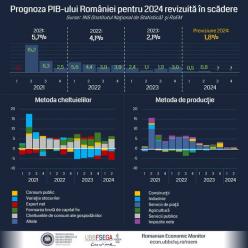Romanian Economic Monitor: Romania's economic growth to reach 1.8pct in 2024, much below initial provisions

The annual growth of Romania's Gross Domestic Product (GDP) will be moderate in 2024, of 1.8%, well below the initial economic forecasts of 3%, despite the positive trends recorded in the first half of the year to also be maintained in the next period as well, according to a team of economists running the Romanian Economic Monitor (RoEM), a research project of the Faculty of Economic Sciences and Business Management of the Babes-Bolyai University in Cluj-Napoca.
According to a press release of the team of economists sent on Wednesday, in September 2024, the National Institute of Statistics published provisional data on Romania's economic growth in the first six months of this year, according to which Romania's GDP registered an increase of 0.8% in the second quarter compared to the first quarter, while in the first quarter an increase of only 0.5% was observed. While these figures might suggest a modest acceleration in economic growth, they are actually below analysts' expectations, which portends lower economic growth for the full year 2024 than expected earlier this year, RoEM research shows.
"Considering these developments, our team revised the forecast for Romania's GDP growth in 2024, reducing it from the level of 3%, estimated at the beginning of the year, to 1.8%, which already includes the effects of the weaker economic performance from the first half of the year. Moreover, this growth rate could decrease even more in case of new unforeseen events compared to those of the first semester. Therefore, in addition to our current forecast of 1.8%, the balance of economic risks until the end of the year inclines more downward," explained Levente Szasz, vice-rector of UBB Cluj-Napoca, coordinator of the Romanian Economic Monitor team.
In the first half of this year, in Romania, there was an increase in domestic demand, stimulated mainly by the real increase in the population's income (including the increase in pensions in the beginning of this year, respectively the increase in the minimum wage per economy in the last quarter of 2023, as well as the gradual reduction of inflation. Although these trends continue in the second half of this year, the team of RoEM economists believes that the less favourable news comes from the companies sector, which fail to fully capitalise on the increase in demand by expanding their offer on the local market.
All sectors of economic activity: agriculture, industry, construction, services, including the IT sector, make modest, and in some cases even negative, contributions to the evolution of Romania's GDP this year, say RoEM specialists.
